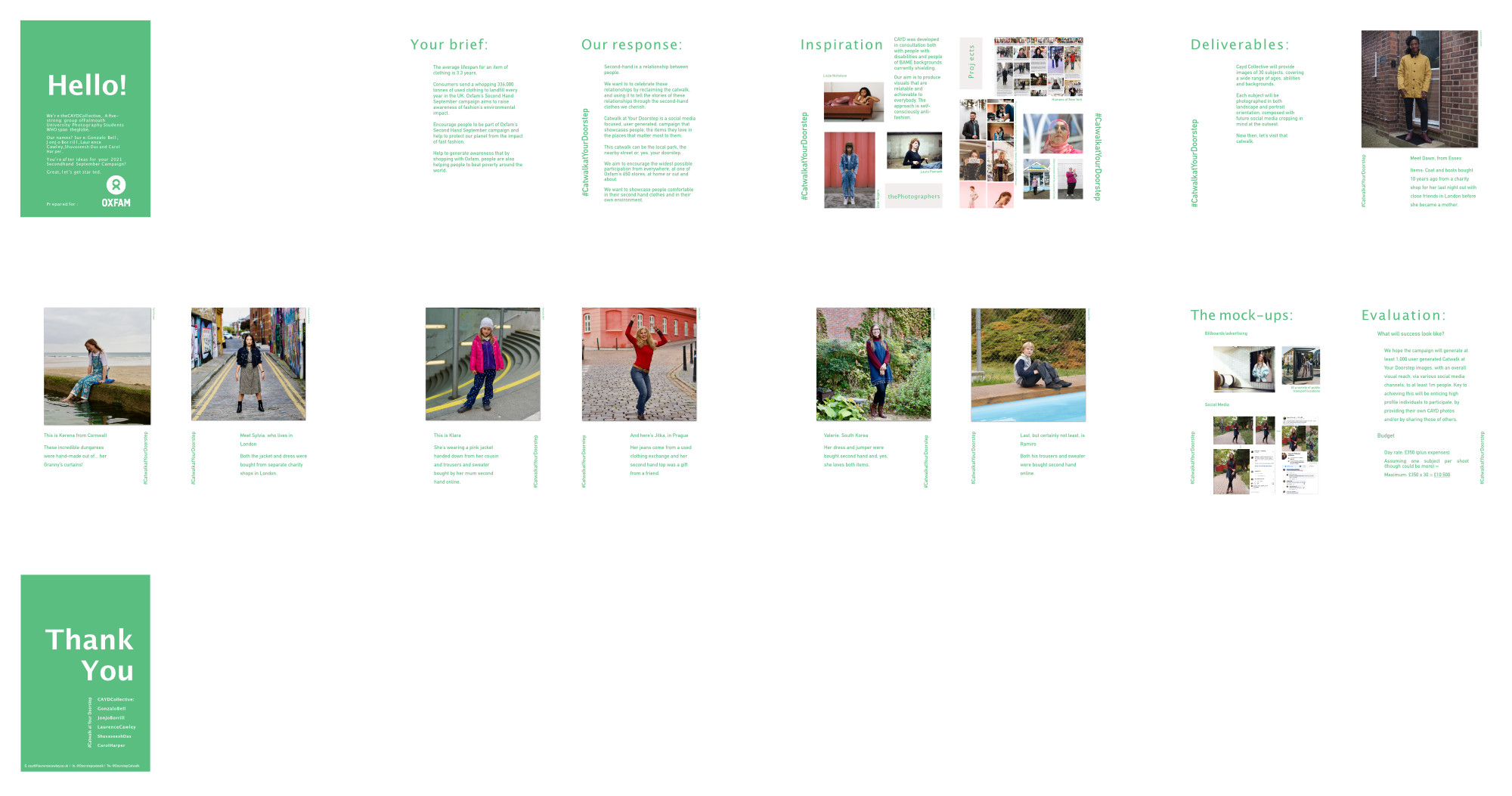The task: To pitch a creative proposal for Oxfam’s 2021 Secondhand September campaign.
The result: Catwalk at Your Doorstep, which was a hybridised group effort which took elements from a number of different early ideas from our group members. At its most basic, the idea was to create a campaign that was especially accessible for as wide a range of people as possible in a mid-pandemic world by photographing the people and their stories of second hand items at their doorstep. It would fundamentally be a social media campaign using the Doorstep Catwalk hashtag.
Evaluation: Oxfam were very polite. But I think the process revealed flaws in both the original brief and our response to it. One of the key elements in the feedback (to both our group and the preceding group) was that we chose to use a hashtag that did not include the word Oxfam. I think we underplayed Oxfam’s desire to control whatever Secondhand September might mean as a sub-brand. To Oxfam, this campaign is not about encouraging people to reuse items at home, or about extending use longevity of items already owned, it is about encouraging people to shop at Oxfam and to donate to Oxfam.
I wonder whether this might have been a flaw in the brief, which made much of the wider societal good of reuse and recycling. It said:
And as we all look to build back a better world, Second Hand September 2020 is a great opportunity to send a message to retailers that we want them to use this year as a chance to come back better for the people who make their clothes. The pandemic has highlighted more than ever the prevalent injustices that factory workers face and we want to support retailers to do better.
Oxfam Brief
I think we were wrong-footed in our idealisation of the campaign, forgetting slightly that there was a paying client, with a large budget, that operates such campaigns as part of its business strategy. Yes, Oxfam wanted to highlight the issues of landfill, employment injustice and wanting ‘to support retailers to do better’ but, as stated above, this campaign is primarily about getting people to shop and donate at Oxfam. It is arguable that recycling can, in the short term at least, have a negative impact on the industry and workers producing new items.
That Oxfam really wanted to improve business for Oxfam is, of course, entirely reasonable. After all, a client is a client: You are serving their interests and the first question must always be what best serves that client. Lesson learned.
I was encouraged that my proposal design was praised. My interest in graphic design was spurred on in the last module when I was grappling with book designs. My graphic design practice, experimentation and reading has continued throughout this model and my use of Affinity Publisher is steadily improving.
I wonder whether we could have nailed down the concept we were pushing more clearly. When I came up with the idea of the doorstep catwalk, it made a great deal of sense to me. The shape of the catwalk seemed (to me) analogous to the shape of the small pathway that joins most homes to the streets they sit upon. But it did not make the same sense to our Oxfam representatives, who associated catwalks with music, lights and clapping audiences. As a result, the images put forward clashed with their expectations of what was coming. To put it bluntly, the pitch underdelivered/confused in terms of expectation.
I’m always mindful of something Ben Smith of Buzzfeed once said about the site’s success:
If your goal — as is ours at BuzzFeed — is to deliver the reader something so new, funny, revelatory, or delightful that they feel compelled to share it, you have to do work that delivers on the headline’s promise, and more.
Ben Smith, buzzfeed
Ultimately, a pitch concept is a headline and the pitch itself is the story. The aim must always be to put a pitch concept that leaves the client wanting to know more and a pitch that overdelivers on what was expected. We didn’t do that, not this time.
References
Smith, B. (n.d.). Why BuzzFeed Doesn’t Do Clickbait. [online] BuzzFeed. Available at: https://www.buzzfeed.com/bensmith/why-buzzfeed-doesnt-do-clickbait [Accessed 21 Nov. 2020].




